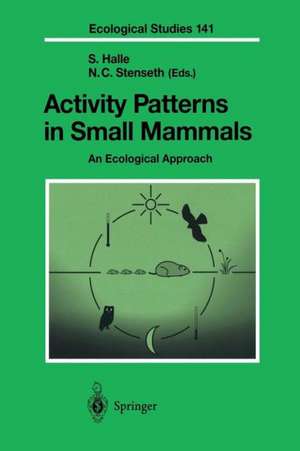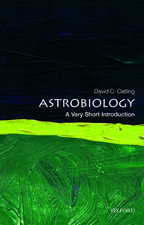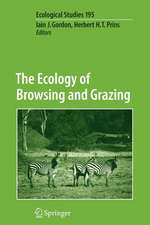Activity Patterns in Small Mammals: An Ecological Approach: Ecological Studies, cartea 141
Editat de S. Halle, N.C. Stensethen Limba Engleză Paperback – 3 oct 2013
| Toate formatele și edițiile | Preț | Express |
|---|---|---|
| Paperback (1) | 946.87 lei 6-8 săpt. | |
| Springer Berlin, Heidelberg – 3 oct 2013 | 946.87 lei 6-8 săpt. | |
| Hardback (1) | 953.03 lei 6-8 săpt. | |
| Springer Berlin, Heidelberg – 6 iul 2000 | 953.03 lei 6-8 săpt. |
Din seria Ecological Studies
- 18%
 Preț: 1118.93 lei
Preț: 1118.93 lei -
 Preț: 553.71 lei
Preț: 553.71 lei - 18%
 Preț: 1680.55 lei
Preț: 1680.55 lei - 18%
 Preț: 1003.38 lei
Preț: 1003.38 lei - 20%
 Preț: 1004.69 lei
Preț: 1004.69 lei -
 Preț: 480.62 lei
Preț: 480.62 lei - 5%
 Preț: 752.26 lei
Preț: 752.26 lei - 15%
 Preț: 643.99 lei
Preț: 643.99 lei - 15%
 Preț: 644.18 lei
Preț: 644.18 lei - 15%
 Preț: 652.49 lei
Preț: 652.49 lei - 18%
 Preț: 789.83 lei
Preț: 789.83 lei -
 Preț: 382.36 lei
Preț: 382.36 lei - 15%
 Preț: 643.48 lei
Preț: 643.48 lei - 15%
 Preț: 646.30 lei
Preț: 646.30 lei - 15%
 Preț: 634.32 lei
Preț: 634.32 lei -
 Preț: 384.86 lei
Preț: 384.86 lei - 18%
 Preț: 789.98 lei
Preț: 789.98 lei - 15%
 Preț: 645.14 lei
Preț: 645.14 lei - 15%
 Preț: 649.39 lei
Preț: 649.39 lei - 18%
 Preț: 1005.43 lei
Preț: 1005.43 lei - 18%
 Preț: 949.23 lei
Preț: 949.23 lei - 15%
 Preț: 649.54 lei
Preț: 649.54 lei - 15%
 Preț: 643.34 lei
Preț: 643.34 lei - 15%
 Preț: 649.71 lei
Preț: 649.71 lei - 15%
 Preț: 638.76 lei
Preț: 638.76 lei - 18%
 Preț: 957.62 lei
Preț: 957.62 lei - 18%
 Preț: 1235.25 lei
Preț: 1235.25 lei - 18%
 Preț: 962.18 lei
Preț: 962.18 lei - 18%
 Preț: 949.23 lei
Preț: 949.23 lei - 15%
 Preț: 660.68 lei
Preț: 660.68 lei -
 Preț: 397.76 lei
Preț: 397.76 lei - 15%
 Preț: 638.24 lei
Preț: 638.24 lei - 18%
 Preț: 942.31 lei
Preț: 942.31 lei - 18%
 Preț: 1232.57 lei
Preț: 1232.57 lei - 15%
 Preț: 651.34 lei
Preț: 651.34 lei - 18%
 Preț: 952.72 lei
Preț: 952.72 lei - 18%
 Preț: 1834.27 lei
Preț: 1834.27 lei - 18%
 Preț: 1229.10 lei
Preț: 1229.10 lei -
 Preț: 423.95 lei
Preț: 423.95 lei - 18%
 Preț: 948.92 lei
Preț: 948.92 lei
Preț: 946.87 lei
Preț vechi: 1154.72 lei
-18% Nou
Puncte Express: 1420
Preț estimativ în valută:
181.21€ • 187.20$ • 150.81£
181.21€ • 187.20$ • 150.81£
Carte tipărită la comandă
Livrare economică 26 martie-09 aprilie
Preluare comenzi: 021 569.72.76
Specificații
ISBN-13: 9783642621284
ISBN-10: 3642621287
Pagini: 348
Ilustrații: XXII, 322 p.
Dimensiuni: 155 x 235 x 18 mm
Greutate: 0.49 kg
Ediția:Softcover reprint of the original 1st ed. 2000
Editura: Springer Berlin, Heidelberg
Colecția Springer
Seria Ecological Studies
Locul publicării:Berlin, Heidelberg, Germany
ISBN-10: 3642621287
Pagini: 348
Ilustrații: XXII, 322 p.
Dimensiuni: 155 x 235 x 18 mm
Greutate: 0.49 kg
Ediția:Softcover reprint of the original 1st ed. 2000
Editura: Springer Berlin, Heidelberg
Colecția Springer
Seria Ecological Studies
Locul publicării:Berlin, Heidelberg, Germany
Public țintă
ResearchCuprins
Section 1 Introduction.- 1 Introduction.- Section II Theoretical Considerations.- Theoretical Considerations — Introduction.- 2 Activity Patterns and the Biological Clock in Mammals.- 3 Activity Patterns and Metabolism.- 4 Ecological Relevance of Daily Activity Patterns.- Section III Empirical Findings.- Empirical Findings — Introduction.- 5 Weasels and Martens — Carnivores in Northern Latitudes.- 6 Mongooses, Civets and Genets — Carnivores in Southern Latitudes.- 7 Squirrels — Medium-Sized Granivores in Woodland Habitats.- 8 Activity Patterns of Kangaroo Rats — Granivores in a Desert Habitat.- 9 Gerbils and Heteromyids — Interspecific Competition and the Spatio-Temporal Niche.- 10 Wood Mice - Small Granivores/Insectivores with Seasonally Variable Patterns.- 11 Voles — Small Graminivores with Polyphasic Patterns.- 12 Djungarian Hamsters — Small Graminivores with Daily Torpor.- 13 Shrews — Small Insectivores with Polyphasic Patterns.- 14 Bats — Flying Nocturnal Mammals.- Section IV Conclusion.- 15 Chronoecology: New Light Through Old Windows — A Conclusion.- Measuring and Analysing Activity of Small Mammals in the Laboratory and in the Field.
Textul de pe ultima copertă
Environmental conditions change considerably in the course of 24 h with respect to abiotic factors and intra- and interspecific interactions. These changes result in limited time windows of opportunity for animal activities and, hence, the question of when to do what is subject to fitness maximisation.
This volume gives a current overview of theoretical considerations and empirical findings of activity patterns in small mammals, a group in which the energetic and ecological constraints are particularly severe and the diversity of activity patterns is particularly high. Following a comparative ecological approach, for the first time activity timing is consequently treated in terms of behavioural and evolutionary ecology, providing the conceptual framework for chronoecology as a new subdiscipline within behavioural ecology. An extensive Appendix gives an introduction to methods of activity modelling and to tools for statistical pattern analysis.
This volume gives a current overview of theoretical considerations and empirical findings of activity patterns in small mammals, a group in which the energetic and ecological constraints are particularly severe and the diversity of activity patterns is particularly high. Following a comparative ecological approach, for the first time activity timing is consequently treated in terms of behavioural and evolutionary ecology, providing the conceptual framework for chronoecology as a new subdiscipline within behavioural ecology. An extensive Appendix gives an introduction to methods of activity modelling and to tools for statistical pattern analysis.
Caracteristici
The first book that links chronobiology with behavioural and evolutionary ecology An excellent reference book for established researchers, providing relevant literature for newcomers to the field Includes an extensive appendix introducing newcomers to empirical aspects of how to monitor activity behaviour and how to analyse the obtained data Includes supplementary material: sn.pub/extras











